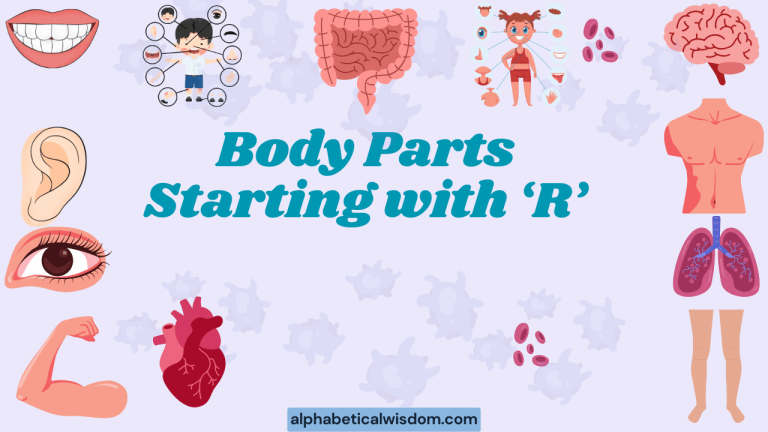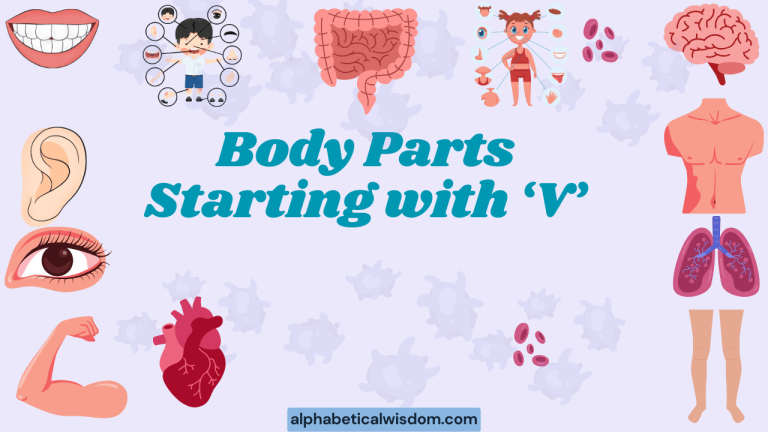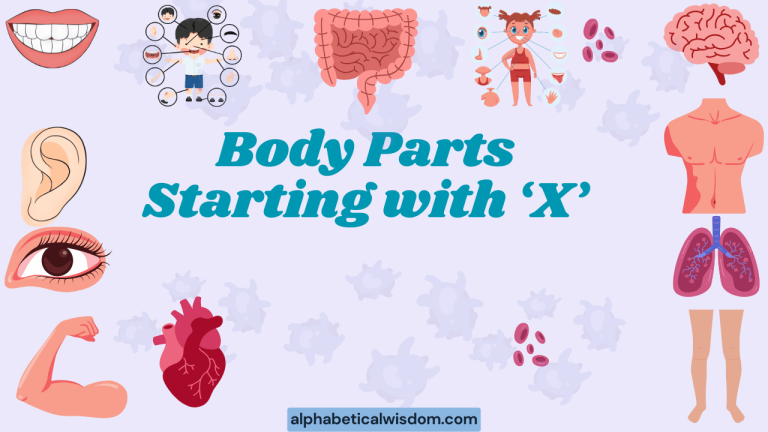Body Parts Starting with Q: A Comprehensive Grammar Guide
Exploring the English language often leads us to intriguing corners, revealing words that are rarely used but still hold a place in our lexicon. Body parts starting with the letter ‘Q’ are a prime example of this.
While not commonly encountered in everyday conversation, understanding these terms can enrich your vocabulary and provide a deeper appreciation for the nuances of English. This article delves into the specific body part that begins with ‘Q,’ its usage, and related grammatical aspects.
This guide is perfect for English language learners, medical professionals, and anyone interested in expanding their knowledge of anatomy and vocabulary.
Table of Contents
- Introduction
- Definition of Quadriceps
- Structural Breakdown of Quadriceps
- Quadriceps Muscles: Types and Categories
- Examples of Quadriceps in Sentences
- Usage Rules for Quadriceps
- Common Mistakes When Using “Quadriceps”
- Practice Exercises
- Advanced Topics: Quadriceps in Medical Terminology
- Frequently Asked Questions (FAQ)
- Conclusion
Definition of Quadriceps
The term “quadriceps” refers to a group of four muscles located on the front of the thigh. The word itself is derived from Latin, with quadri meaning “four” and ceps referring to the head or origin of the muscle. These four muscles work together to extend the knee joint, allowing us to perform activities such as walking, running, jumping, and squatting. The quadriceps are crucial for lower body strength and stability, and understanding their function is vital for both athletes and individuals recovering from injuries.
In anatomical terms, the quadriceps are classified as skeletal muscles, meaning they are attached to bones and are responsible for voluntary movement. They play a significant role in locomotion and maintaining posture.
The quadriceps are also essential for shock absorption during activities like landing from a jump. Weak or injured quadriceps can lead to knee pain, instability, and difficulty performing everyday tasks.
Therefore, maintaining their strength and flexibility is important for overall physical health.
Structural Breakdown of Quadriceps
The quadriceps muscle group consists of four distinct muscles, each with its unique origin and insertion point. These muscles converge to form a single tendon that attaches to the patella (kneecap) and then extends down to the tibial tuberosity (a bony prominence on the front of the tibia or shinbone).
This arrangement allows the quadriceps to effectively extend the knee joint. Understanding the individual components of the quadriceps is essential for targeted training and rehabilitation.
The four muscles that make up the quadriceps are the rectus femoris, vastus lateralis, vastus medialis, and vastus intermedius. The rectus femoris is unique because it crosses both the hip and knee joints, making it a hip flexor as well as a knee extensor. The vastus muscles, on the other hand, only cross the knee joint. The vastus lateralis is located on the outer side of the thigh, the vastus medialis on the inner side, and the vastus intermedius lies deep beneath the rectus femoris. Together, these muscles provide powerful and coordinated knee extension.
Quadriceps Muscles: Types and Categories
Each of the four quadriceps muscles has distinct characteristics and functions, contributing to the overall action of knee extension. Understanding these individual roles is key to optimizing training and rehabilitation programs.
Rectus Femoris
The rectus femoris is the most superficial of the quadriceps muscles and the only one that crosses both the hip and knee joints. It originates from the anterior inferior iliac spine (AIIS) of the pelvis and inserts onto the tibial tuberosity via the patellar tendon. This unique arrangement allows the rectus femoris to contribute to both hip flexion and knee extension. It is particularly important for activities that require both movements simultaneously, such as kicking a ball or sprinting.
Vastus Lateralis
The vastus lateralis is the largest of the quadriceps muscles and is located on the lateral (outer) side of the thigh. It originates from the greater trochanter, intertrochanteric line, and linea aspera of the femur and inserts onto the tibial tuberosity via the patellar tendon. The vastus lateralis is primarily responsible for knee extension and plays a crucial role in providing stability to the knee joint during movement.
Vastus Medialis
The vastus medialis is located on the medial (inner) side of the thigh. It originates from the intertrochanteric line and linea aspera of the femur and inserts onto the tibial tuberosity via the patellar tendon. The vastus medialis is particularly important for the final degrees of knee extension and helps to maintain proper patellar tracking, preventing patellofemoral pain syndrome (runner’s knee).
Vastus Intermedius
The vastus intermedius lies deep beneath the rectus femoris and originates from the anterior and lateral surfaces of the femur. It inserts onto the tibial tuberosity via the patellar tendon. The vastus intermedius is primarily responsible for knee extension and works in synergy with the other quadriceps muscles to provide powerful and coordinated movement.
Examples of Quadriceps in Sentences
Here are examples of how the term “quadriceps” can be used in sentences, illustrating its application in various contexts. The following tables will show the usage of “quadriceps” in general, in medical contexts, and in athletic contexts.
These examples should clarify how to incorporate the term into your vocabulary.
Table 1: General Usage of “Quadriceps”
| Sentence | Context |
|---|---|
| Regular exercise helps strengthen the quadriceps. | General fitness |
| The doctor recommended stretches to improve quadriceps flexibility. | Health and wellness |
| Weak quadriceps can contribute to knee pain. | Medical condition |
| She felt a sharp pain in her quadriceps after the run. | Physical activity |
| Proper form is crucial when performing exercises that target the quadriceps. | Exercise technique |
| The quadriceps are essential for walking and running. | Basic movement |
| He focused on strengthening his quadriceps to improve his squat. | Weightlifting |
| The therapist massaged her quadriceps to relieve muscle tension. | Therapy |
| Tight quadriceps can limit range of motion. | Flexibility |
| The athlete underwent surgery to repair a torn quadriceps. | Sports injury |
| Stretching the quadriceps before a workout can help prevent injuries. | Preventative care |
| The quadriceps muscle group is located on the front of the thigh. | Anatomy |
| Proper nutrition is important for quadriceps muscle recovery. | Nutrition |
| The strength of the quadriceps is important for maintaining balance. | Balance |
| He felt a cramp in his quadriceps during the soccer game. | Sports |
| The quadriceps are responsible for extending the knee. | Function |
| She used a foam roller to release tension in her quadriceps. | Self-care |
| The quadriceps work in coordination with the hamstrings. | Muscle synergy |
| He performed lunges to strengthen his quadriceps and glutes. | Exercise |
| The quadriceps are important for generating power during jumping. | Power |
| Maintaining strong quadriceps is important as you age. | Aging |
| The quadriceps muscles contribute significantly to lower body strength. | Strength |
| The effectiveness of the rehabilitation program was measured by assessing quadriceps strength. | Rehabilitation |
| After the injury, regaining quadriceps strength was a primary goal. | Recovery |
| The trainer emphasized the importance of quadriceps exercises. | Training |
| He felt a burning sensation in his quadriceps during the intense workout. | Intense Exercise |
Table 2: “Quadriceps” in Medical Contexts
| Sentence | Context |
|---|---|
| The MRI revealed a tear in the patient’s quadriceps tendon. | Diagnosis |
| Quadriceps atrophy can occur after prolonged immobilization. | Medical condition |
| The physical therapist focused on strengthening the patient’s quadriceps post-surgery. | Rehabilitation |
| The doctor prescribed medication to reduce inflammation in the quadriceps. | Treatment |
| Electrotherapy was used to stimulate the quadriceps muscles. | Therapy |
| The examination revealed significant weakness in the left quadriceps. | Physical examination |
| The surgeon repaired the ruptured quadriceps tendon. | Surgery |
| Quadriceps tendinitis can cause pain and stiffness in the knee. | Medical condition |
| The patient reported difficulty extending the knee due to quadriceps weakness. | Symptoms |
| The physician assessed the patient’s quadriceps strength using manual muscle testing. | Assessment |
| The patient’s gait was affected by the weakness in their quadriceps. | Gait Analysis |
| The use of crutches was recommended to reduce the load on the quadriceps. | Assistive Devices |
| Imaging techniques are essential for diagnosing quadriceps injuries. | Diagnostics |
| The rehabilitation protocol included specific exercises targeting the quadriceps. | Rehabilitation Protocol |
| The patient was referred to a specialist for further evaluation of their quadriceps injury. | Referral |
| The quadriceps reflex was tested as part of the neurological examination. | Neurology |
| The doctor explained the importance of quadriceps strengthening exercises. | Patient Education |
| The severity of the quadriceps strain was graded based on the extent of the tear. | Grading |
| The patient was advised to avoid activities that aggravated their quadriceps pain. | Advice |
| The recovery time for a quadriceps injury depends on the severity. | Recovery Time |
| The doctor monitored the patient’s quadriceps function throughout the treatment. | Monitoring |
| Post-operative care is crucial for optimal quadriceps recovery. | Post-operative Care |
| The physiotherapist used ultrasound therapy on the patient’s quadriceps. | Ultrasound Therapy |
| The quadriceps muscles play a vital role in knee joint stability. | Knee Stability |
| The patient’s quadriceps strength was assessed before and after the intervention. | Pre- and Post-Assessment |
| The rehabilitation program aimed to restore full quadriceps function. | Restoration |
Table 3: “Quadriceps” in Athletic Contexts
| Sentence | Context |
|---|---|
| The athlete focused on building quadriceps strength to improve his sprint speed. | Performance enhancement |
| Her quadriceps were sore after the intense leg workout. | Training fatigue |
| The coach emphasized the importance of stretching the quadriceps to prevent injuries. | Injury prevention |
| He felt a strain in his quadriceps during the basketball game. | Sports injury |
| The cyclist’s quadriceps were well-developed due to the demands of the sport. | Physical conditioning |
| She performed squats to target her quadriceps and glutes. | Exercise |
| The trainer recommended lunges to strengthen the athlete’s quadriceps. | Training regimen |
| The runner’s quadriceps propelled him forward during the race. | Running performance |
| The jumper relied on his powerful quadriceps to generate lift. | Jumping ability |
| The swimmer’s quadriceps helped to stabilize his legs during kicking. | Swimming technique |
| The athlete used resistance bands to strengthen their quadriceps. | Resistance Training |
| Proper warm-up is crucial to prepare the quadriceps for intense activity. | Warm-up |
| The athlete’s quadriceps strength was a key factor in their success. | Success Factor |
| The coach monitored the athlete’s quadriceps performance during training sessions. | Monitoring |
| The athlete’s quadriceps injury sidelined him for several weeks. | Sidelined |
| The athlete was working with a physical therapist to rehabilitate their quadriceps. | Rehabilitation |
| The athlete’s quadriceps strength was measured using dynamometry. | Measurement |
| The athlete focused on eccentric exercises to strengthen their quadriceps. | Eccentric Exercises |
| The athlete used foam rolling to release tension in their quadriceps after training. | Foam Rolling |
| The strength and flexibility of the quadriceps are crucial for athletic performance. | Athletic Performance |
| The athlete focused on plyometric exercises to improve quadriceps power. | Plyometrics |
| The athlete’s quadriceps muscle mass increased with consistent training. | Muscle Mass |
| The athlete’s quadriceps strength was a competitive advantage. | Competitive Advantage |
| The athlete’s recovery strategy included ice baths to reduce quadriceps inflammation. | Recovery Strategy |
| The athlete focused on unilateral exercises to address quadriceps imbalances. | Unilateral Exercises |
Usage Rules for Quadriceps
When using the term “quadriceps,” it’s important to remember that it is a plural noun, referring to a group of four muscles. Therefore, it should be treated as plural in your sentences.
However, it is commonly used in a singular sense when referring to the entire muscle group as a unit. This can sometimes lead to confusion, but understanding the context can help clarify the intended meaning.
Here are some key rules to keep in mind:
- When referring to the entire muscle group as a whole, you can use singular verbs and pronouns: “The quadriceps is a large muscle group.”
- When referring to the individual muscles within the group, use plural verbs and pronouns: “The quadriceps are composed of four muscles.”
- Be consistent with your usage within a sentence or paragraph to avoid confusion.
Common Mistakes When Using “Quadriceps”
One common mistake is treating “quadriceps” as a singular noun when it refers to multiple muscles. Another common error is incorrect verb conjugation due to confusion about whether to treat it as singular or plural.
Here are some examples of common mistakes and their corrections:
Table 4: Common Mistakes and Corrections
| Incorrect | Correct | Explanation |
|---|---|---|
| The quadriceps is responsible for extending the knee, it is very important. | The quadriceps are responsible for extending the knee; they are very important. | “Quadriceps” refers to a group of muscles, so plural pronouns and verbs should be used. |
| He injured his quadricep during the game. | He injured his quadriceps during the game. | The correct term is “quadriceps,” not “quadricep.” |
| The quadriceps are a very strong muscle. | The quadriceps is a very strong muscle group. | When referring to the entire group as a unit, singular verbs can be used. |
| Quadriceps weakness cause knee pain. | Quadriceps weakness causes knee pain. | Incorrect verb form. |
| The quadriceps attach to the patella and extend down to the tibial tuberosity, providing knee extension. | The quadriceps attach to the patella and extend down to the tibial tuberosity, providing knee extension. | No correction needed. This sentence is correct. |
Practice Exercises
Test your understanding of “quadriceps” with these practice exercises. Fill in the blanks with the correct form of the word or the appropriate verb conjugation.
Exercise 1: Fill in the Blanks
Complete the following sentences using the correct form of “quadriceps” and appropriate verb conjugations.
- Regular exercise helps to strengthen the __________.
- The doctor recommended stretching the __________ to improve flexibility.
- Weak __________ can contribute to knee pain.
- She felt a sharp pain in her __________ after the run.
- Proper form is crucial when performing exercises that target the __________.
- The __________ are essential for walking and running.
- He focused on strengthening his __________ to improve his squat.
- The therapist massaged her __________ to relieve muscle tension.
- Tight __________ can limit range of motion.
- The athlete underwent surgery to repair a torn __________.
Answer Key:
- quadriceps
- quadriceps
- quadriceps
- quadriceps
- quadriceps
- quadriceps
- quadriceps
- quadriceps
- quadriceps
- quadriceps
Exercise 2: Correct the Sentences
Identify and correct the errors in the following sentences related to the use of “quadriceps.”
- The quadricep is a large muscle on the front of the thigh.
- His quadriceps was sore after the workout.
- She felt a pull in her quadriceps, it was very painful.
- The quadriceps attach to the patella, it is important for knee function.
- Quadriceps weakness can cause knee pain, this is a common problem.
- The quadriceps is made up of four muscles.
- He worked hard to strengthen his quadriceps, it improved his jumping ability.
- The quadriceps help you extend your knee, it’s an important muscle.
- The quadriceps are important for athletes, it helps them run faster.
- The doctor examined his quadriceps, he found a slight strain.
Answer Key:
- The quadriceps is a large muscle group on the front of the thigh.
- His quadriceps were sore after the workout.
- She felt a pull in her quadriceps; it was very painful.
- The quadriceps attach to the patella; they are important for knee function.
- Quadriceps weakness can cause knee pain; this is a common problem. (No change needed, sentence is correct)
- The quadriceps are made up of four muscles.
- He worked hard to strengthen his quadriceps; this improved his jumping ability.
- The quadriceps help you extend your knee; they are an important muscle.
- The quadriceps are important for athletes; they help them run faster.
- The doctor examined his quadriceps; he found a slight strain. (No change needed, sentence is correct)
Advanced Topics: Quadriceps in Medical Terminology
In medical terminology, the quadriceps are often referenced in the context of injuries, rehabilitation, and surgical procedures. Understanding the specific terminology related to the quadriceps can be beneficial for healthcare professionals and those interested in advanced anatomy. Common terms include quadriceps tendinitis (inflammation of the quadriceps tendon), quadriceps rupture (a tear in the quadriceps muscle or tendon), and quadriceps atrophy (muscle wasting due to disuse or injury). Furthermore, specific surgical procedures, such as quadriceps tendon repair, involve specialized techniques and terminology that require advanced knowledge of anatomy and surgical principles.
The Q-angle, or quadriceps angle, is another important concept in medical terminology related to the quadriceps. This angle is formed by a line from the anterior superior iliac spine (ASIS) to the mid-patella and a line from the tibial tuberosity to the mid-patella. The Q-angle is used to assess patellar tracking and identify potential risk factors for patellofemoral pain syndrome. An abnormally high Q-angle can indicate malalignment of the lower extremity and increase the risk of knee pain and instability. Understanding the Q-angle and its implications is essential for clinicians involved in the diagnosis and treatment of knee disorders.
Frequently Asked Questions (FAQ)
- What are the four muscles that make up the quadriceps?
The four muscles that make up the quadriceps are the rectus femoris, vastus lateralis, vastus medialis, and vastus intermedius. Each muscle has a unique origin and insertion point, but they all work together to extend the knee joint.
- What is the primary function of the quadriceps?
The primary function of the quadriceps is to extend the knee joint. This action is essential for activities such as walking, running, jumping, and squatting. The quadriceps also contribute to hip flexion, particularly the rectus femoris muscle.
- How can I strengthen my quadriceps?
You can strengthen your quadriceps through various exercises, including squats, lunges, leg presses, and leg extensions. It’s important to use proper form and gradually increase the intensity and resistance to avoid injury.
- What is quadriceps tendinitis?
Quadriceps tendinitis is an inflammation of the quadriceps tendon, which connects the quadriceps muscles to the patella. It can cause pain, stiffness, and tenderness in the front of the knee. Treatment typically involves rest, ice, compression, and elevation (RICE), as well as physical therapy to strengthen the quadriceps and improve flexibility.
- What are the symptoms of a quadriceps strain?
The symptoms of a quadriceps strain can vary depending on the severity of the injury. Common symptoms include pain, swelling, bruising, and difficulty extending the knee. In severe cases, there may be a palpable gap or deformity in the muscle.
- How is a quadriceps strain treated?
Treatment for a quadriceps strain typically involves RICE therapy, pain medication, and physical therapy. In severe cases, surgery may be necessary to repair a torn muscle or tendon. The rehabilitation process focuses on restoring strength, flexibility, and function to the quadriceps.
- What is the Q-angle, and why is it important?
The Q-angle, or quadriceps angle, is the angle formed by a line from the anterior superior iliac spine (ASIS) to the mid-patella and a line from the tibial tuberosity to the mid-patella. It is used to assess patellar tracking and identify potential risk factors for patellofemoral pain syndrome. An abnormally high Q-angle can indicate malalignment of the lower extremity and increase the risk of knee pain and instability.
- Can weak quadriceps contribute to knee pain?
Yes, weak quadriceps can significantly contribute to knee pain. The quadriceps muscles play a crucial role in stabilizing the knee joint and controlling movement. When these muscles are weak, they may not be able to adequately support the knee, leading to increased stress on the joint and surrounding structures. This can result in pain, particularly during activities like walking, running, or climbing stairs. Strengthening the quadriceps is often a key component of rehabilitation programs for various knee conditions.
- What are some exercises to avoid if I have quadriceps tendinitis?
If you have quadriceps tendinitis, it’s generally advisable to avoid exercises that place excessive stress on the quadriceps tendon. This includes activities such as deep squats, lunges with excessive forward knee movement, and high-impact exercises like jumping or running uphill. These exercises can exacerbate inflammation and pain. It’s best to consult with a physical therapist or healthcare professional to determine a safe and appropriate exercise program.
- How long does it take to recover from a quadriceps strain?
The recovery time for a quadriceps strain varies depending on the severity of the injury. A mild strain (Grade 1) may take a few weeks to heal, while a moderate strain (Grade 2) could require several weeks to a few months. A severe strain (Grade 3), which involves a complete tear of the muscle, may necessitate surgery and a more extensive rehabilitation period, potentially lasting several months. Factors such as age, overall health, and adherence to a rehabilitation program can also influence recovery time.
Conclusion
While the term “quadriceps” might be the only body part starting with ‘Q’ commonly encountered, understanding its meaning and usage is crucial for anyone studying anatomy, fitness, or medicine. This article has provided a detailed overview of the quadriceps muscle group, its structure, function, and common related issues.
By mastering the information presented here, you can confidently use the term in both academic and practical contexts.
Remember to practice using “quadriceps” in sentences and be mindful of the rules governing its usage. Consistent application and review will solidify your understanding and prevent common mistakes.
Continue to explore the fascinating world of English vocabulary, and don’t be afraid to delve into the less frequently used words – they often hold valuable insights and enrich your overall language proficiency.






